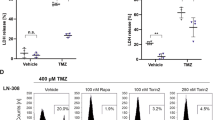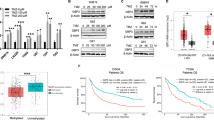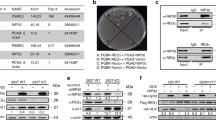Abstract
Glioblastoma multiforme is an aggressive form of brain cancer that responds poorly to chemotherapy and is generally incurable. The basis for the poor response of this cancer to chemotherapy is not well understood. The atypical protein kinases C (PKCι and PKCζ) have previously been implicated in leukaemia cell chemoresistance. To assess the role of atypical PKC in glioblastoma cell chemoresistance, RNA interference was used to deplete human glioblastoma cells of PKCι. Transfection of cells with either of two different RNA duplexes specific for PKCι caused a partial sensitisation to cell death induced by the chemotherapy agent cisplatin. To screen for possible mechanisms for PKCι-mediated chemoresistance, microarray analysis of gene expression was performed on RNA from glioblastoma cells that were either untreated or depleted of PKCι. This identified sets of genes that were regulated either positively or negatively by PKCι. Within the set of genes that were negatively regulated by PKCι, the function of the gene coding for GMFβ, an enhancer of p38 mitogen-activated protein kinase (MAP kinase) signaling, was investigated further, as the p38 MAP kinase pathway has been previously identified as a key mediator of cisplatin cytotoxicity. The expression of both GMFβ mRNA and protein increased upon PKCι depletion, and this was accompanied by an increase in cisplatin-activated p38 MAP kinase signaling. Transient overexpression of GMFβ increased cisplatin-activated p38 MAP kinase signaling and also sensitised cells to cisplatin cytotoxicity. The increase in cisplatin cytotoxicity seen with PKCι depletion was blocked by the p38 MAP kinase inhibitor SKF86002. These data show that PKCι can confer partial resistance to cisplatin in glioblastoma cells by suppressing GMFβ-mediated enhancement of p38 MAP kinase signaling.
This is a preview of subscription content, access via your institution
Access options
Subscribe to this journal
Receive 50 print issues and online access
$259.00 per year
only $5.18 per issue
Buy this article
- Purchase on Springer Link
- Instant access to full article PDF
Prices may be subject to local taxes which are calculated during checkout








Similar content being viewed by others
Abbreviations
- PKC:
-
protein kinase C
- PDK1:
-
phosphoinositide-dependent kinase 1
- PI 3-kinase:
-
phosphoinositide 3-kinase
- GMFβ:
-
glia maturation factor β
- MAP kinase:
-
mitogen-activated protein kinase
- TNFα:
-
tumor necrosis factor α
- SAM:
-
significance analysis of microarrays
- ERK:
-
extracellular signal-regulated kinase
- MTT:
-
3-(4,5-cimethylthiazol-2-yl)-2,5-diphenyl tetrazolium bromide
References
Altschul SF, Madden TL, Schaffer AA, Zhang J, Zhang Z, Miller W et al. (1997). Nucleic Acids Res 25: 3389–3402.
Benhar M, Engelberg D, Levitzki A . (2002). EMBO Rep 3: 420–425.
Berra E, Municio MM, Sanz L, Frutos S, Diaz-Meco MT, Moscat J . (1997). Mol Cell Biol 17: 4346–4354.
Brigstock DR . (2003). J Endocrinol 178: 169–175.
Choi BK, Choi CH, Oh HL, Kim YK . (2004). Neurotoxicology 25: 915–924.
Diaz-Meco MT, Moscat J . (2001). Mol Cell Biol 21: 1218–1227.
Filomenko R, Poirson-Bichat F, Billerey C, Belon JP, Garrido C, Solary E et al. (2002). Cancer Res 62: 1815–1821.
Garcia-Cao I, Lafuente MJ, Criado LM, Diaz-Meco MT, Serrano M, Moscat J . (2003). EMBO Rep 4: 307–312.
Gentleman RC, Carey VJ, Bates DM, Bolstad B, Dettling M, Dudoit S et al. (2004). Genome Biol 5: R80.
Hanigan MH, Deng M, Zhang L, Taylor Jr PT, Lapus MG . (2005). Am J Physiol Renal Physiol 288: F125–F132.
Holland EC . (2001). Nat Rev Genet 2: 120–129.
Inagaki M, Aoyama M, Sobue K, Yamamoto N, Morishima T, Moriyama A et al. (2004). Biochim Biophys Acta 1670: 208–216.
Ishii N, Maier D, Merlo A, Tada M, Sawamura Y, Diserens AC et al. (1999). Brain Pathol 9: 469–479.
Jin Z, Xin M, Deng X . (2005). J Biol Chem 280: 16045–16052.
Kaimori JY, Takenaka M, Nakajima H, Hamano T, Horio M, Sugaya T et al. (2003). J Biol Chem 278: 33519–33527.
Kanzaki M, Mora S, Hwang JB, Saltiel AR, Pessin JE . (2004). J Cell Biol 164: 279–290.
Le Bail O, Schmidt-Ullrich R, Israel A . (1993). EMBO J 12: 5043–5049.
Leitges M, Sanz L, Martin P, Duran A, Braun U, Garcia JF et al. (2001). Mol Cell 8: 771–780.
Lim R, Zaheer A . (1996). J Biol Chem 271: 22953–22956.
Lim R, Zaheer A, Khosravi H, Freeman Jr JH, Halverson HE, Wemmie JA et al. (2004). Brain Res 1024: 225–232.
Lorimer IA, Lavictoire SJ . (2000). J Immunol Meth 237: 147–157.
Lorimer IA . (2002). Curr Cancer Drug Targets 2: 91–102.
Losa JH, Parada CC, Viniegra JG, Sanchez-Arevalo LV, Cajal S, Sanchez-Prieto R . (2003). Oncogene 22: 3998–4006.
Lu W, Yamamoto V, Ortega B, Baltimore D . (2004). Cell 119: 97–108.
Lu Y, Jamieson L, Brasier AR, Fields AP . (2001). Oncogene 20: 4777–4792.
Mayo MW, Baldwin AS . (2000). Biochim Biophys Acta 1470: M55–M62.
Moscat J, Diaz-Meco MT . (2000). EMBO Rep 1: 399–403.
Moscatello DK, Holgado-Madruga M, Emlet DR, Montgomery RB, Wong AJ . (1998). J Biol Chem 273: 200–206.
Murray NR, Fields AP . (1997). J Biol Chem 272: 27 521–27 524.
Sansal I, Sellers WR . (2004). J Clin Oncol 22: 2954–2963.
Semizarov D, Frost L, Sarthy A, Kroeger P, Halbert DN, Fesik SW . (2003). Proc Natl Acad Sci USA 100: 6347–6352.
Soloff RS, Katayama C, Lin MY, Feramisco JR, Hedrick SM . (2004). J Immunol 173: 3250–3260.
Stupp R, Mason WP, van den Bent MJ, Weller M, Fisher B, Taphoorn MJ et al. (2005). N Engl J Med 352: 987–996.
Tusher VG, Tibshirani R, Chu G . (2001). Proc Natl Acad Sci USA 98: 5116–5121.
Vanhaesebroeck B, Alessi DR . (2000). Biochem J 346 (Part 3): 561–576.
Zaheer A, Yang B, Cao X, Lim R . (2004). Neurochem Res 29: 1473–1480.
Zhan Y, O'Rourke DM . (2004). Cancer Res 64: 8292–8298.
Acknowledgements
We thank Pearl A Campbell and the staff of the Ontario Genomics Innovation Centre for performing the microarray analysis described here. Thanks also to Gordon Barrett for critical reading of this manuscript. This work was supported by grants from the Canadian Cancer Society (to IAJL) and the Canadian Institutes of Health Research (to IAJL). RMB is the recipient of an Ontario Graduate Scholarship in Science and Technology; PMK is the recipient of a Stem Cell Network studentship. MAA holds a Canada Research Chair in Bioinformatics.
Author information
Authors and Affiliations
Corresponding author
Rights and permissions
About this article
Cite this article
Baldwin, R., Garratt-Lalonde, M., Parolin, D. et al. Protection of glioblastoma cells from cisplatin cytotoxicity via protein kinase Cι-mediated attenuation of p38 MAP kinase signaling. Oncogene 25, 2909–2919 (2006). https://doi.org/10.1038/sj.onc.1209312
Received:
Revised:
Accepted:
Published:
Issue Date:
DOI: https://doi.org/10.1038/sj.onc.1209312
Keywords
This article is cited by
-
Molecular Association of Glia Maturation Factor with the Autophagic Machinery in Rat Dopaminergic Neurons: a Role for Endoplasmic Reticulum Stress and MAPK Activation
Molecular Neurobiology (2019)
-
Induction of senescence in primary glioblastoma cells by serum and TGFβ
Scientific Reports (2017)
-
Inhibition of protein kinase CK2 sensitizes non-small cell lung cancer cells to cisplatin via upregulation of PML
Molecular and Cellular Biochemistry (2017)
-
PKCiota promotes ovarian tumor progression through deregulation of cyclin E
Oncogene (2016)
-
The Interruption of PKC-ι Signaling and TRAIL Combination Therapy Against Glioblastoma Cells
Neurochemical Research (2014)



